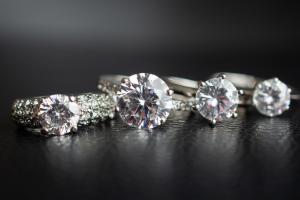
Understanding the 4 Cs of Diamonds: Key Information for Sellers Before Visiting a Buyer
The 4 Cs were established by the Gemological Institute of America (GIA) and have since become the international standard for evaluating and comparing diamonds. These factors do not function independently; rather, they interact to influence the overall value and marketability of a diamond. For sellers, understanding how each element plays into pricing is essential.
Cut
Contrary to popular belief, "cut" does not refer to a diamond's shape (such as round, oval, or princess), but rather how well the diamond's facets interact with light. A well-cut diamond will exhibit brilliance, fire, and scintillation—traits that dramatically impact how the diamond appears and, in turn, its resale value.
“A poorly cut diamond can look dull even if it’s high in clarity and color,” said Bowers. “Cut is one of the most overlooked factors by sellers, but it heavily affects buyer interest.”
The GIA grading system for cut ranges from Excellent to Poor. Most resellers, including pawn shops and private buyers, give strong preference to diamonds with Very Good or Excellent cut grades, especially in the round brilliant shape, which is the most widely traded.
Color
Color is graded on a scale from D (completely colorless) to Z (noticeable yellow or brown tint). The closer a diamond is to colorless, the more valuable it generally becomes—though demand also plays a role depending on shape and size.
Diamonds in the D–F range are considered “colorless,” while G–J fall into the “near colorless” category, still retaining high market appeal. As the grade descends, resale value tends to decline unless the diamond is unusually large or uniquely cut.
It is worth noting that fancy colored diamonds—those with strong hues such as yellow, pink, or blue—follow a different pricing model. Sellers in possession of such stones are advised to request evaluation from someone familiar with colored diamond markets.
Clarity
Clarity refers to the presence of internal or external imperfections, known as inclusions and blemishes, respectively. The GIA clarity scale includes eleven grades, ranging from Flawless (FL) to Included (I1–I3).
While flawless diamonds are rare, most marketable stones fall into the VS (Very Slightly Included) to SI (Slightly Included) categories. Inclusions that are not visible to the naked eye typically have little impact on visual appeal but can affect pricing significantly when compared on paper.
In resale scenarios, clarity impacts are especially relevant for larger stones. Minor inclusions in smaller diamonds may not affect overall value significantly, but in diamonds over 1.00 carat, buyers examine clarity more closely.
Carat Weight
Carat weight is a measurement of a diamond’s mass, not its size—though the two are often correlated. One carat equals 200 milligrams. As carat weight increases, the price-per-carat typically rises at an exponential rate, rather than linear.
However, Bowers cautions that carat weight alone doesn’t guarantee value. “A 2.00-carat diamond with poor cut, color, and clarity will often fetch less than a well-balanced 1.00-carat stone,” he explained.
Buyers also tend to focus on common weight thresholds—such as 0.50, 1.00, 1.50, and 2.00 carats. Stones that fall just under those thresholds may be penalized less than sellers expect, while stones that hit them precisely may receive a slight premium.
Additional Considerations
Beyond the 4 Cs, several other factors may affect resale value:
Certification: Diamonds that come with GIA, AGS, or IGI certifications are easier to evaluate and sell. Uncertified diamonds may be subject to wider pricing discrepancies.
Mountings and Settings: While sellers often hope to include the ring or pendant in the sale, buyers generally evaluate the stone alone unless the setting is from a luxury brand or includes additional gemstones.
Market Demand: Like any commodity, diamond pricing can fluctuate based on supply and consumer interest. Size and shape trends also shift over time.
Sellers are advised to gather documentation, clean their stones, and prepare for evaluation with a clear understanding that secondhand resale values differ from retail pricing. The original purchase price—especially from mall jewelers—may not reflect the true secondary market value.
By understanding the 4 Cs and how they impact value, individuals seeking to sell diamonds can approach the process informed, realistic, and ready to navigate offers based on market fundamentals rather than sentiment.
Morgan Thomas
Rhino Digital, LLC
+1 504-875-5036
email us here
Visit us on social media:
Facebook
Distribution channels: Consumer Goods, Culture, Society & Lifestyle, Science, World & Regional
Legal Disclaimer:
EIN Presswire provides this news content "as is" without warranty of any kind. We do not accept any responsibility or liability for the accuracy, content, images, videos, licenses, completeness, legality, or reliability of the information contained in this article. If you have any complaints or copyright issues related to this article, kindly contact the author above.
Submit your press release

